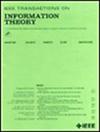Optimal Best Arm Identification With Fixed Confidence in Restless Bandits
IF 2.2
3区 计算机科学
Q3 COMPUTER SCIENCE, INFORMATION SYSTEMS
引用次数: 0
Abstract
We study best arm identification in a restless multi-armed bandit setting with finitely many arms. The discrete-time data generated by each arm forms a homogeneous Markov chain taking values in a common, finite-state space. The state transitions in each arm are captured by an ergodic transition probability matrix (TPM) that is a member of a single-parameter exponential family of TPMs. The real-valued parameters of the arm TPMs are unknown and belong to a given space. Given a function f defined on the common state space of the arms, the goal is to identify the best arm—the arm with the largest average value of f evaluated under the arm’s stationary distribution—with the fewest number of samples, subject to an upper bound on the decision’s error probability (i.e., the fixed-confidence regime). A lower bound on the growth rate of the expected stopping time is established in the asymptote of a vanishing error probability. Furthermore, a policy for best arm identification is proposed, and its expected stopping time is proved to have an asymptotic growth rate that matches the lower bound. It is demonstrated that tracking the long-term behavior of a certain Markov decision process and its state-action visitation proportions are the key ingredients in analyzing the converse and achievability bounds. It is shown that under every policy, the state-action visitation proportions satisfy a specific approximate flow conservation constraint and that these proportions match the optimal proportions dictated by the lower bound under any asymptotically optimal policy. The prior studies on best arm identification in restless bandits focus on independent observations from the arms, rested Markov arms, and restless Markov arms with known arm TPMs. In contrast, this work is the first to study best arm identification in restless bandits with unknown arm TPMs.以固定置信度对不安定盗贼进行最佳手臂识别
我们研究了在具有有限多个手臂的不安定多臂强盗环境中的最佳手臂识别。每个手臂产生的离散时间数据形成一个同质马尔可夫链,在一个共同的有限状态空间中取值。每个手臂的状态转换由一个遍历转换概率矩阵(TPM)捕捉,该矩阵是 TPM 单参数指数族的成员。臂 TPM 的实值参数未知,属于给定空间。给定一个定义在各臂共同状态空间上的函数 f,目标是根据决策错误概率的上限(即固定置信度),用最少的样本识别出最佳臂--在臂的静态分布下,f 的平均值最大的臂。在误差概率消失的渐近线上,建立了预期停止时间增长率的下限。此外,还提出了一种最佳臂识别策略,并证明其预期停止时间的渐近增长率与下限相匹配。研究表明,跟踪某一马尔可夫决策过程的长期行为及其状态-行动访问比例是分析逆界和可实现性界的关键因素。研究表明,在每种政策下,状态-行动访问比例都满足特定的近似流量保护约束,并且这些比例与任何渐近最优政策下的下限所规定的最优比例相匹配。之前关于躁动匪帮中最佳手臂识别的研究主要集中在手臂、静止马尔可夫手臂和已知手臂 TPM 的躁动马尔可夫手臂的独立观察上。相比之下,本研究首次研究了具有未知手臂 TPM 的不安分匪徒的最佳手臂识别。
本文章由计算机程序翻译,如有差异,请以英文原文为准。
求助全文
约1分钟内获得全文
求助全文
来源期刊

IEEE Transactions on Information Theory
工程技术-工程:电子与电气
CiteScore
5.70
自引率
20.00%
发文量
514
审稿时长
12 months
期刊介绍:
The IEEE Transactions on Information Theory is a journal that publishes theoretical and experimental papers concerned with the transmission, processing, and utilization of information. The boundaries of acceptable subject matter are intentionally not sharply delimited. Rather, it is hoped that as the focus of research activity changes, a flexible policy will permit this Transactions to follow suit. Current appropriate topics are best reflected by recent Tables of Contents; they are summarized in the titles of editorial areas that appear on the inside front cover.
 求助内容:
求助内容: 应助结果提醒方式:
应助结果提醒方式:


